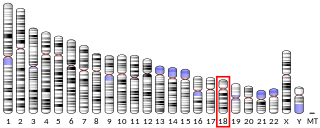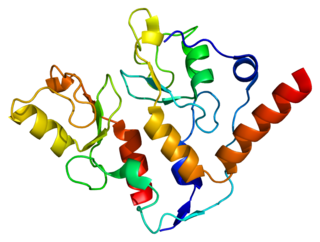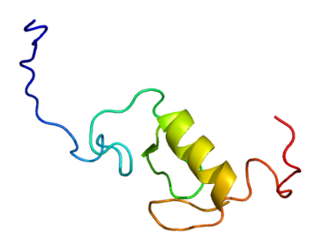The human KDM2B gene encodes the protein lysine (K)-specific demethylase 2B. [5]
The human KDM2B gene encodes the protein lysine (K)-specific demethylase 2B. [5]
KDM2B is broadly and highly expressed in embryonic tissues (especially in the developing central nervous system of vertebrates). Expression of KDM2B is also retained in most organs in adults. [6] The protein is present in the nucleoplasm and is enriched in the nucleolus where it binds the transcribed region of ribosomal RNA to represses the transcription of ribosomal RNA genes which inhibits cell growth and proliferation. [7]
KDM2B protein has several domains including a JmjC domain that has a histone demethylase activity demethylating trimethylated Lys-4 and dimethylated Lys-36 of histone H3. [8] [7] KDM2B specifically recognizes and bind non-methylated DNA in CpG islands through its ZF-CxxC DNA binding domain. [9] KDM2B consequently recruits the non-canonical polycomb repressive complex 1.1 (ncPRC1) to unmethylated CpG islands via a direct interaction with BCOR and PCGF1 [10] leading to the mono-ubiquitylation of histone H2A on K119 and gene repression. [11] [12] [13] [14] [15]
This gene encodes a member of the F-box protein family which is characterized by an approximately 40 amino acid motif, the F-box. The F-box proteins constitute one of the four subunits of ubiquitin protein ligase complex called SCFs (SKP1-cullin-F-box), which function in phosphorylation-dependent ubiquitination. The F-box proteins are divided into 3 classes: Fbws containing WD-40 domains, Fbls containing leucine-rich repeats, and Fbxs containing either different protein-protein interaction modules or no recognizable motifs. The protein encoded by this gene belongs to the Fbls class. Multiple alternatively spliced transcript variants have been found for this gene, but the full-length nature of some variants has not been determined. [5]
As part of the ncPRC1.1 complex, KDM2B was found to be rapidly and transiently recruited to sites of DNA damage in a PARP1- and TIMELESS-dependent manner to promote mono-ubiquitylation of histone H2A on K119 with concomitant local decrease of H2A levels and an increase of H2A.Z. These events promote transcriptional repression at DNA lesions, double strand break signaling, and homologous recombination repair. The activity of the ncPRC1.1 complex at DNA lesions was necessary for the proper recruitment of the two canonical PRC1 complexes (cPRC1.2 and cPRC1.4), defined by their PCGF subunits, MEL18 and BMI1 respectively. Therefore, recruitment of the ncPRC1.1 complex represents an early and critical regulatory step in homologous recombination repair. [16]
Loss of KDM2B leads to severe developmental defects (growth defects in the brain, including failure of neural tube closure and craniofacial malformations, hematopoietic development) leading to embryonic lethality [17]

In biology, histones are highly basic proteins abundant in lysine and arginine residues that are found in eukaryotic cell nuclei. They act as spools around which DNA winds to create structural units called nucleosomes. Nucleosomes in turn are wrapped into 30-nanometer fibers that form tightly packed chromatin. Histones prevent DNA from becoming tangled and protect it from DNA damage. In addition, histones play important roles in gene regulation and DNA replication. Without histones, unwound DNA in chromosomes would be very long. For example, each human cell has about 1.8 meters of DNA if completely stretched out; however, when wound about histones, this length is reduced to about 90 micrometers (0.09 mm) of 30 nm diameter chromatin fibers.
Heterochromatin is a tightly packed form of DNA or condensed DNA, which comes in multiple varieties. These varieties lie on a continuum between the two extremes of constitutive heterochromatin and facultative heterochromatin. Both play a role in the expression of genes. Because it is tightly packed, it was thought to be inaccessible to polymerases and therefore not transcribed; however, according to Volpe et al. (2002), and many other papers since, much of this DNA is in fact transcribed, but it is continuously turned over via RNA-induced transcriptional silencing (RITS). Recent studies with electron microscopy and OsO4 staining reveal that the dense packing is not due to the chromatin.
In molecular biology and genetics, transcriptional regulation is the means by which a cell regulates the conversion of DNA to RNA (transcription), thereby orchestrating gene activity. A single gene can be regulated in a range of ways, from altering the number of copies of RNA that are transcribed, to the temporal control of when the gene is transcribed. This control allows the cell or organism to respond to a variety of intra- and extracellular signals and thus mount a response. Some examples of this include producing the mRNA that encode enzymes to adapt to a change in a food source, producing the gene products involved in cell cycle specific activities, and producing the gene products responsible for cellular differentiation in multicellular eukaryotes, as studied in evolutionary developmental biology.
Polycomb-group proteins are a family of protein complexes first discovered in fruit flies that can remodel chromatin such that epigenetic silencing of genes takes place. Polycomb-group proteins are well known for silencing Hox genes through modulation of chromatin structure during embryonic development in fruit flies. They derive their name from the fact that the first sign of a decrease in PcG function is often a homeotic transformation of posterior legs towards anterior legs, which have a characteristic comb-like set of bristles.
Demethylases are enzymes that remove methyl (CH3) groups from nucleic acids, proteins (particularly histones), and other molecules. Demethylases are important epigenetic proteins, as they are responsible for transcriptional regulation of the genome by controlling the methylation of DNA and histones, and by extension, the chromatin state at specific gene loci.
Chromatin remodeling is the dynamic modification of chromatin architecture to allow access of condensed genomic DNA to the regulatory transcription machinery proteins, and thereby control gene expression. Such remodeling is principally carried out by 1) covalent histone modifications by specific enzymes, e.g., histone acetyltransferases (HATs), deacetylases, methyltransferases, and kinases, and 2) ATP-dependent chromatin remodeling complexes which either move, eject or restructure nucleosomes. Besides actively regulating gene expression, dynamic remodeling of chromatin imparts an epigenetic regulatory role in several key biological processes, egg cells DNA replication and repair; apoptosis; chromosome segregation as well as development and pluripotency. Aberrations in chromatin remodeling proteins are found to be associated with human diseases, including cancer. Targeting chromatin remodeling pathways is currently evolving as a major therapeutic strategy in the treatment of several cancers.

Paired amphipathic helix protein Sin3a is a protein that in humans is encoded by the SIN3A gene.

Methyl-CpG-binding domain protein 2 is a protein that in humans is encoded by the MBD2 gene.

Core histone macro-H2A.1 is a protein that in humans is encoded by the H2AFY gene.

C-terminal-binding protein 2 also known as CtBP2 is a protein that in humans is encoded by the CTBP2 gene.

E3 ubiquitin-protein ligase RING1 is an enzyme that in humans is encoded by the RING1 gene.

Lysine-specific demethylase 4A is an enzyme that in humans is encoded by the KDM4A gene.

Lysine-specific demethylase 2A (KDM2A) also known as F-box and leucine-rich repeat protein 11 (FBXL11) is an enzyme that in humans is encoded by the KDM2A gene. KDM2A is a member of the superfamily of alpha-ketoglutarate-dependent hydroxylases, which are non-haem iron-containing proteins.

Lysine-specific demethylase 6A also known as Ubiquitously transcribed tetratricopeptide repeat, X chromosome (UTX), is a protein which in humans is encoded by the KDM6A gene. It belongs to the 2-oxoglutarate (2OG)-dependent dioxygenase superfamily.

Polycomb group RING finger protein 6 is a protein that in humans is encoded by the PCGF6 gene.

Polycomb group RING finger protein 1, PCGF1, also known as NSPC1 or RNF68 is a RING finger domain protein that in humans is encoded by the PCGF1 gene.

PRC2 is one of the two classes of polycomb-group proteins or (PcG). The other component of this group of proteins is PRC1.
H3K27me3 is an epigenetic modification to the DNA packaging protein Histone H3. It is a mark that indicates the tri-methylation of lysine 27 on histone H3 protein.

Rob Klose is a Canadian researcher and Professor of Genetics at the Department of Biochemistry, University of Oxford. His research investigates how chromatin-based and epigenetic mechanisms contribute to the ways in which gene expression is regulated.

Yi Zhang is a Chinese-American biochemist who specializes in the fields of epigenetics, chromatin, and developmental reprogramming. He is a Fred Rosen Professor of Pediatrics and professor of genetics at Harvard Medical School, a senior investigator of Program in Cellular and Molecular Medicine at Boston Children's Hospital, and an investigator of the Howard Hughes Medical Institute. He is also an associate member of the Harvard Stem Cell Institute, as well as the Broad Institute of MIT and Harvard. He is best known for his discovery of several classes of epigenetic enzymes and the identification of epigenetic barriers of SCNT cloning.
This article incorporates text from the United States National Library of Medicine, which is in the public domain.